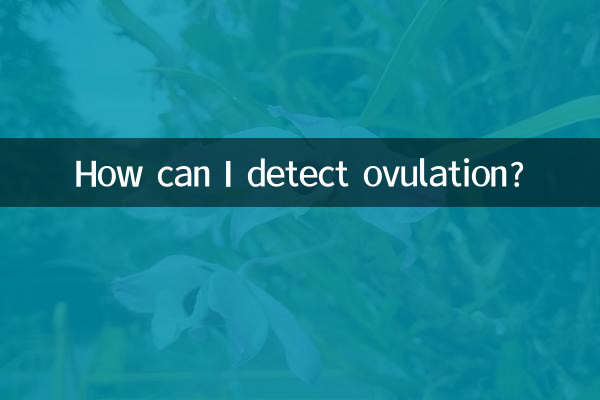How can I detect ovulation?
Ovulation is an important part of the female reproductive cycle. Accurate prediction of ovulation time can help women better plan for fertility or contraception. This article will introduce several common ovulation monitoring methods, and sort out the hot topics and hot content on the Internet in the past 10 days to help you understand the practical information of ovulation monitoring more comprehensively.
1. Common ovulation monitoring methods

The following are several ovulation monitoring methods currently widely used and their characteristics:
| method | Principle | Advantages | Disadvantages |
|---|---|---|---|
| basal body temperature method | By measuring body temperature daily, observe the rising trend of body temperature after ovulation | Low cost and simple operation | It requires long-term persistence and is susceptible to interference from external factors. |
| Ovulation test strips | Detection of peak levels of luteinizing hormone (LH) in urine | High accuracy and easy to use | Requires multiple tests and costs more |
| cervical mucus observation method | Determine ovulation by observing changes in cervical mucus | No additional tools required | Requires some experience and is highly subjective |
| Ultrasound monitoring | Observe follicle development through B-ultrasound | most accurate method | Need to go to the hospital for examination, which is more expensive |
| Smart wearable devices | Predict ovulation based on body temperature, heart rate and other data | High degree of automation | Equipment prices are higher |
2. Popular ovulation monitoring topics on the Internet in the past 10 days
According to the data analysis of the entire network, the following are the recent hot topics and hot content about ovulation monitoring:
| topic | heat index | Main discussion content |
|---|---|---|
| Smart bracelet monitors ovulation accuracy | 85 | Discuss the ovulation prediction function and accuracy of various smart bracelets |
| Tips for using ovulation test strips | 92 | Share how to use and time to improve the accuracy of ovulation test strips |
| Impact of COVID-19 vaccine on menstrual cycle | 78 | Exploring whether vaccination affects ovulation cycles and ability to conceive |
| Polycystic ovary syndrome and ovulation disorders | 65 | Discuss ovulation monitoring methods and treatment recommendations for PCOS patients |
| Ovulation calculation in natural contraceptive methods | 70 | Share methods and experiences on how to use natural contraception by monitoring ovulation |
3. How to choose the ovulation monitoring method that suits you
When choosing an ovulation monitoring method, you should consider the following factors:
1.purpose: Is it for pregnancy preparation or contraception? Preparing for pregnancy may require more precise methods, such as ovulation test strips or ultrasound monitoring.
2.budget: Ovulation test strips and smart devices require a certain amount of investment, while the basal body temperature method costs less.
3.Convenience: People with busy work may be more suitable to use smart devices for automatic monitoring.
4.health status: Women with irregular menstruation or gynecological diseases may need professional guidance from a doctor.
4. Tips to improve the accuracy of ovulation monitoring
1. Combine multiple monitoring methods, such as using basal body temperature and ovulation test strips at the same time.
2. Maintain a regular schedule and avoid staying up late and overexertion.
3. Record your menstrual cycle for at least 3 months to understand your own regularity.
4. Drink less water 2 hours before the test to improve the accuracy of the ovulation test paper.
5. Interpret monitoring results under the guidance of a doctor to avoid misjudgment.
5. Common Misunderstandings in Ovulation Monitoring
1. It is believed that ovulation must occur on the 14th day of the menstrual cycle (actually it varies from person to person).
2. Ignore the impact of stress, disease and other factors on ovulation.
3. Over-reliance on a single monitoring method.
4. Equating ovulation with the fertile period (sperm can actually survive in a woman’s body for several days).
By monitoring ovulation through scientific methods, women can more accurately understand their fertility cycles. It is recommended to choose the appropriate method based on individual circumstances and consult a professional doctor if necessary.

check the details

check the details